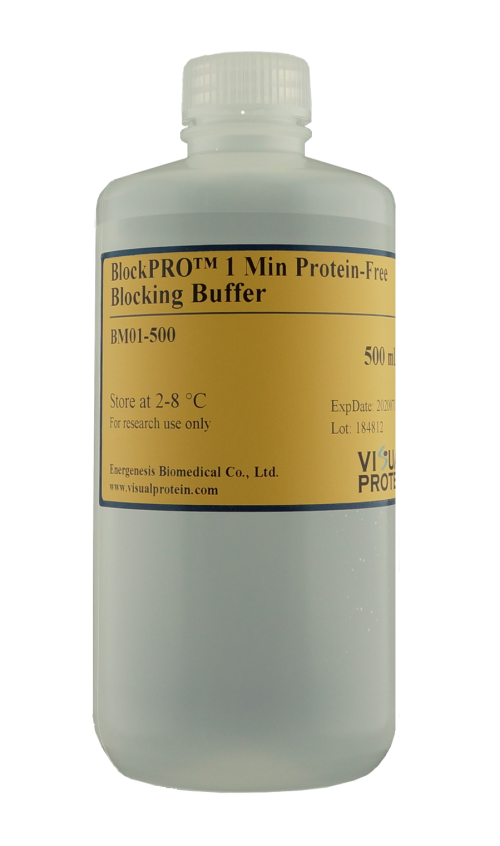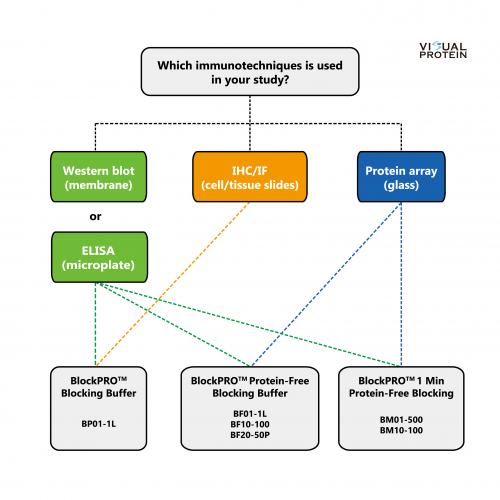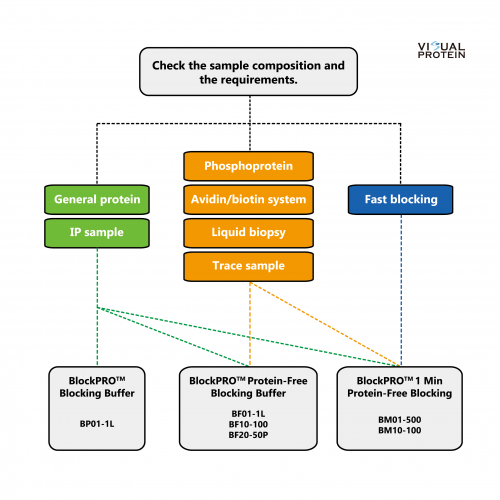Product
Western Blots & Immunoassays
BlockPRO™ 1 Min Protein-Free Blocking Buffer
Complete the blocking step in only 1 minute.
BlockPRO™ 1 Min Protein-Free Blocking Buffer is a fast blocking buffer for Western blotting with non-protein formulation containing 0.05% Tween-20 surfactant. It effectively prevents protein cross-reaction and improves the signal/noise ratio of the detected signals by one-minute blocking. BlockPRO™ 1 Min Protein-Free Blocking Buffer can be applied to immunodetection systems including antibodies and biotin/avidin systems such as ELISA, Western blotting, immunohistochemistry and other immunochemical applications.
BlockPRO™ 1 Min Protein-Free Blocking Buffer is a fast blocking buffer for Western blotting with non-protein formulation containing 0.05% Tween-20 surfactant. It effectively prevents protein cross-reaction and improves the signal/noise ratio of the detected signals by one-minute blocking. BlockPRO™ 1 Min Protein-Free Blocking Buffer can be applied to immunodetection systems including antibodies and biotin/avidin systems such as ELISA, Western blotting, immunohistochemistry and other immunochemical applications.
產品資訊
Highlights:
- Fast blocking: the enhanced formula shortens the blocking time to 1 minute
- Protein-free: eliminates cross-reactivity happened in traditional protein-based blocking buffers
- Antibody diluent: for diluting primary and secondary antibodies and extending the storage time of antibodies
Order Information:
| Cat. No. | Product Name | Description |
| BM01-500 |
BlockPRO™ 1 Min Protein-Free Blocking Buffer |
500mL Solution X 1 |
| BM10-100 | BlockPRO™ 1 Min Protein-Free Blocking Buffer (10X) |
100mL Solution X 1 |
Product Detail:
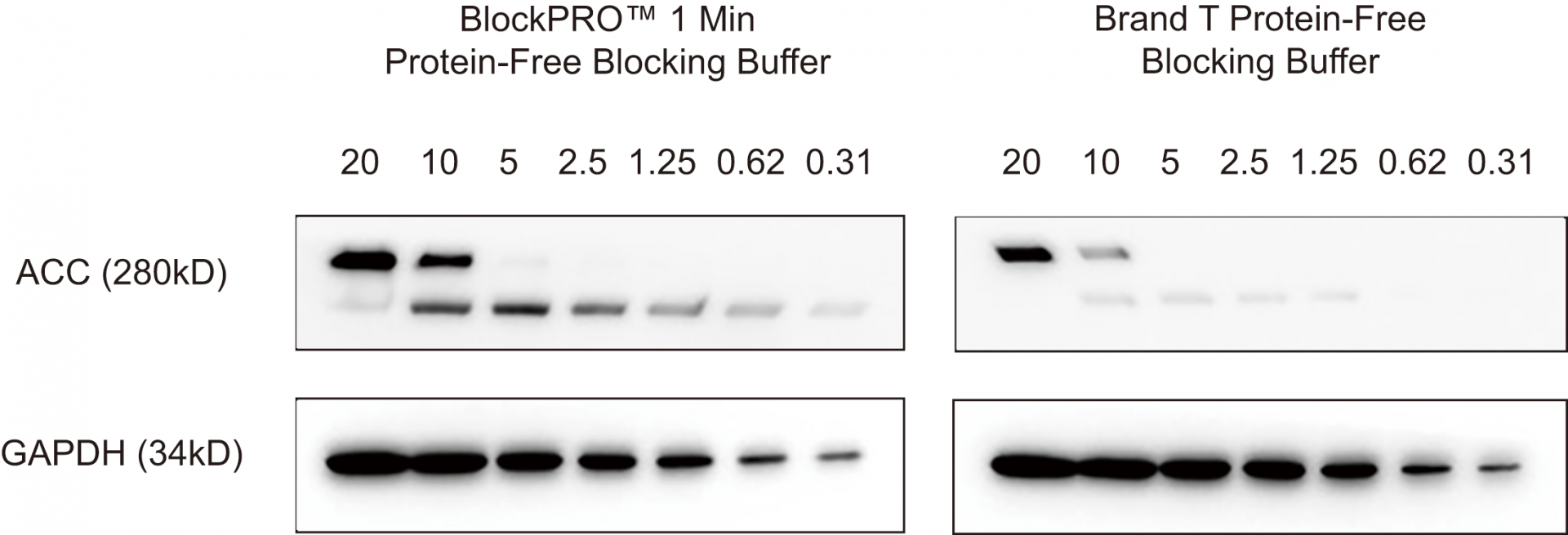
Figure 1. BlockPRO™ 1 Min Protein-Free Blocking Buffer enhanced the signal intensity and shorten the blocking time to 1 min.
20 μg of Huh-7 cell lysates were serial diluted and separated by electrophoresis. The proteins were transferred to PVDF and blocked for 1 min at room temperature with BlockPRO™ 1 Min or 1 hour in competitor's product (as indicated), probed with mouse anti-ACC followed by anti-mouse HRP and detected with LumiFlash™ Ultima Chemiluminescent Substrate.
Selection Guide:
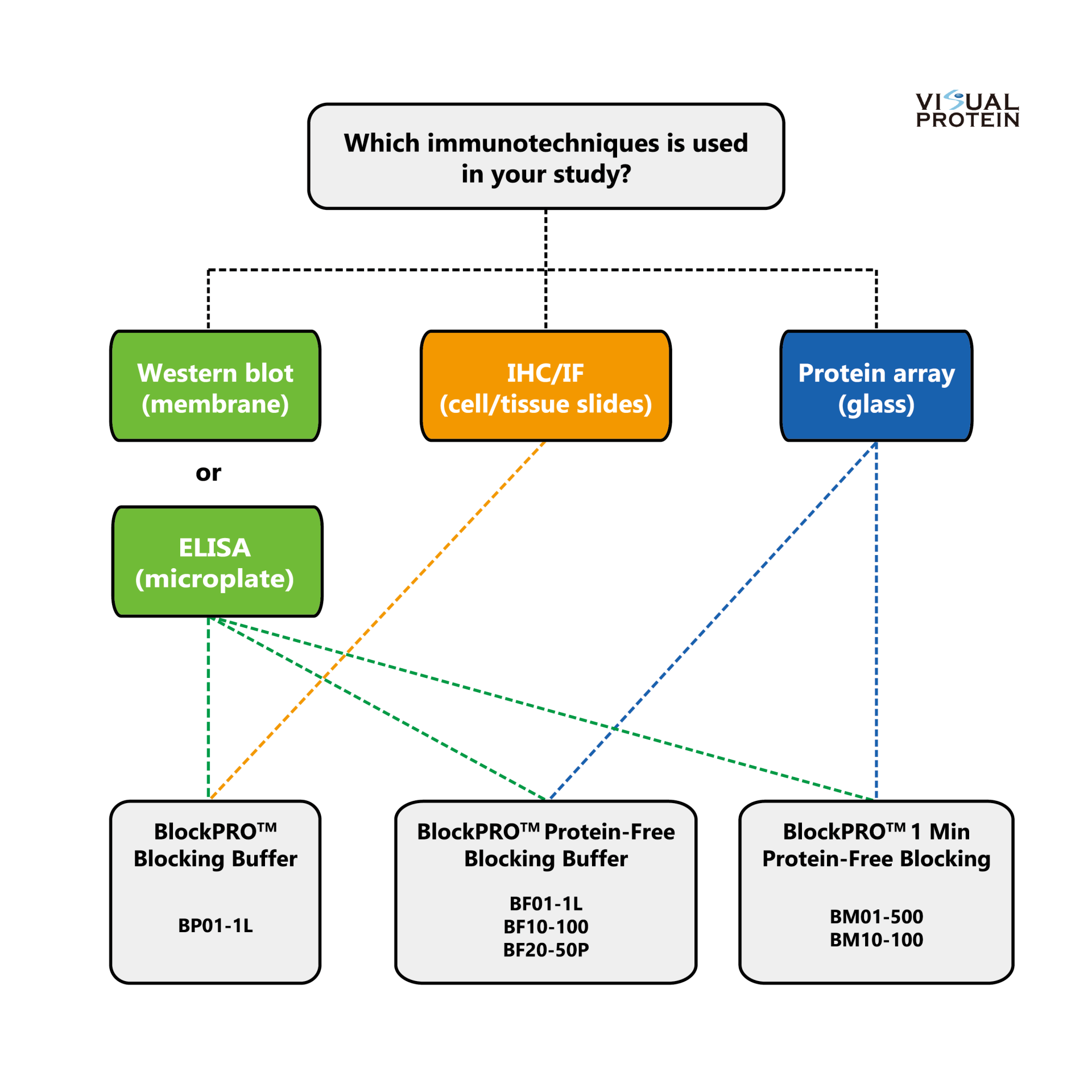
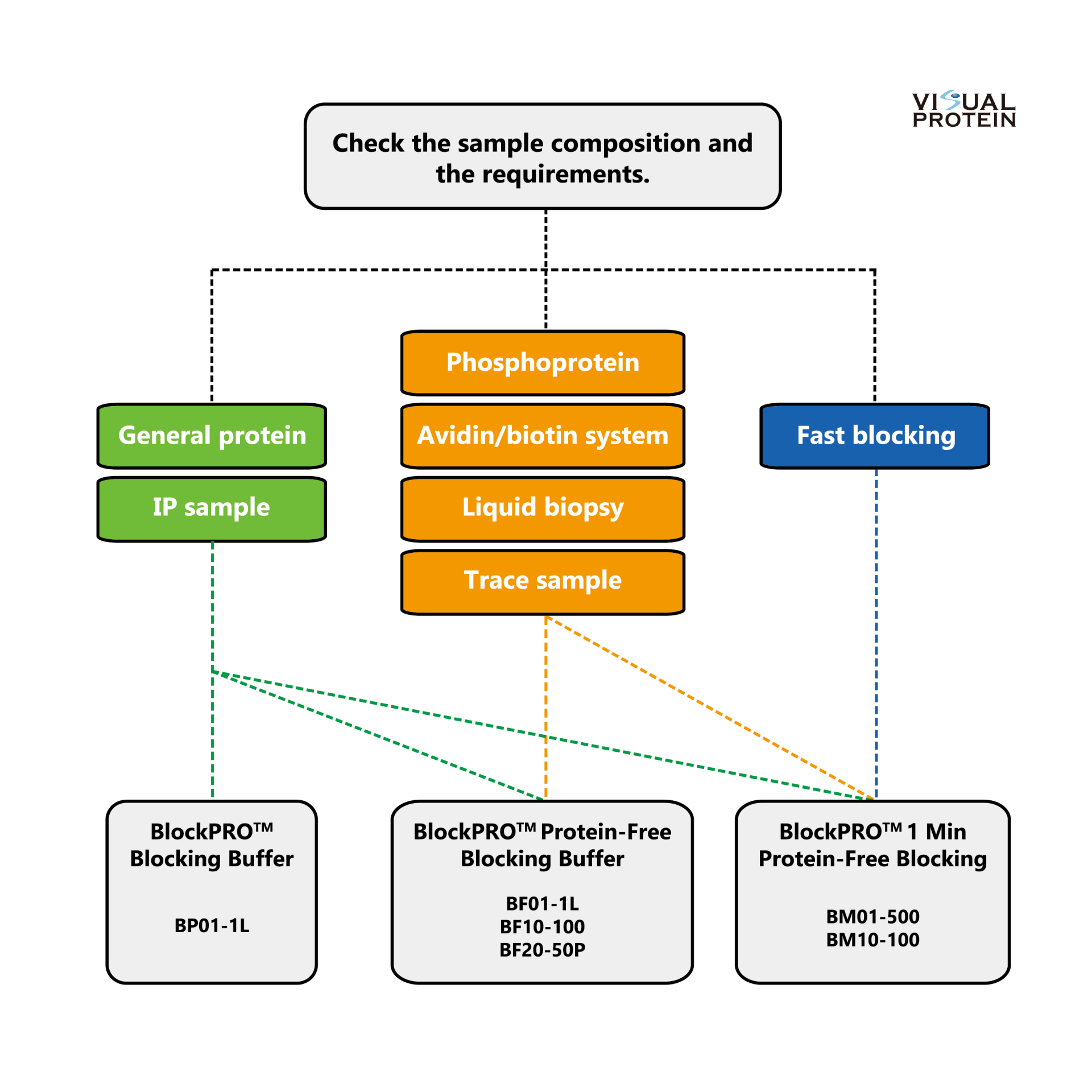
Reference:
| Item | Description | Application | Link |
| 1 | Hsueh, Cheng-Shun, et al. "Role of nuclear factor-kappa B in feline injection site sarcoma." BMC veterinary research 15.1 (2019) | WB | PMID: 31653220 |
| 2 | Lin, Yuan‐Hau, et al. “The study of isotopic enrichment of water in human plasma and erythrocyte.” The FASEB Journal 34.9 (2020): 13049-13062. | WB | PMID: 32779304 |
| 3 | Su, Kuan-Wei, et al. “Repurposing cabozantinib with therapeutic potential in KIT-driven t (8; 21) acute myeloid leukaemias.” Cancer Gene Therapy (2021) | WB | PMID: 33833412 |
| 4 | Chen, Shih-Heng, et al. "Extracellular Vesicles of Adipose-Derived Stem Cells Promote the Healing of Traumatized Achilles Tendons." International Journal of Molecular Sciences 22.22 (2021) | WB | PMID: 34830254 |
| 5 | Shih, Cheng-Hsin, et al. "Investigating the role of signal transducer and activator of transcription 3 in feline injection site sarcoma." BMC Veterinary Research 18.1 (2022) | IHC | PMID: 35836213 |
| 6 | Wang, Ya‐Chin, et al. "NPRL2 down‐regulation facilitates the growth of hepatocellular carcinoma via the mTOR pathway and autophagy suppression." Hepatology Communications 6.12 (2022) | WB | PMID: 36321403 |
| 7 | Chang, Hsin-Han, et al. "ONX-0914 Induces Apoptosis and Autophagy with p53 Regulation in Human Glioblastoma Cells." Cancers 14.22 (2022) | WB | PMID: 36428804 |
| 8 | Tang, Ya-Xin, et al. "Lipophilic constituents in Salvia miltiorrhiza Inhibit activation of the hepatic stellate cells by suppressing the JAK1/STAT3 signaling pathway: A network pharmacology study and experimental validation." Frontiers in Pharmacology 13 (2022) | WB | PMID: 35517817 |
| 9 | Liao, Tzu-Chieh, et al. "Granulocytic MDSC with deficient CCR5 alleviates lipogenesis and inflammation in nonalcoholic fatty liver disease." International Journal of Molecular Sciences 23.21 (2022) | WB | PMID: 36361830 |
| 10 | Cheng, Chia-Hsiung, et al. "Plasmon-activated water as a therapeutic strategy in Alzheimer’s disease by altering gut microbiota." Aging (Albany NY) 15.9 (2023) | WB | PMID: 37166426 |
| 11 | Hsiao, Wen-Wei, et al. "Antifungal Activity of Cedrol from Cunninghamia lanceolate var. konishii against Phellinus noxius and Its Mechanism." Plants 13.2 (2024): 321. | WB | PMID: 38276778 |
| 12 | Chen, Shih-Heng, et al. "The Transplantation of 3-Dimensional Spheroids of Adipose-Derived Stem Cells Promotes Achilles Tendon Healing in Rabbits by Enhancing the Proliferation of Tenocytes and Suppressing M1 Macrophages." The American Journal of Sports Medicine (2024) | WB | PMID: 38193194 |
| 13 | Chomthong, Kittima, et al. "Label-free simultaneous detection of quinolone antibiotic residues using an origami paper–based electrochemical immunosensor." Sensors and Actuators B: Chemical 410 (2024) | Immunosensor | LINK |
| 14 | Mana, Natjira, et al. "Naturally Derived Terpenoids Targeting the 3Dpol of Foot-and-Mouth Disease Virus: An Integrated In Silico and In Vitro Investigation." Viruses 16.7 (2024) | Immunoperoxidase Monolayer Assay | PMID: 39066290 |
| 15 | SY Changi, et al. "Arsenic-induced disruption of circadian rhythms and glutamine anaplerosis in human urothelial carcinoma." Journal of Trace Elements in Medicine and Biology (2024) | WB | PMID: 39137608 |
| 16 | Hsiao, He-Yun, et al. "Stabilization of AMPK/PFKL/RPIA in the Glycolytic Bodies Transduces IL6/STAT3 Signal in Hepatocarcinogenesis." bioRxiv (2024) | IF | LINK |
| 17 | Kao, Chien-Chang, et al. "GW4064 inhibits migration and invasion through cathepsin B and MMP2 downregulation in human bladder cancer." Chemico-Biological Interactions 389 (2024): 110869. | WB | PMID: 38216027 |
| 18 | Lin, Meng Ting, et al. "Investigation into the synergistic effect of atorvastatin combined with ultrasound stimulation for anti‑glioma therapy." Oncology Letters 30.4 (2025): 1-13. | WB | PMID: 40799299 |
| 19 | Boonto, Thammachanok, Chinnatam Phetkong, and Chaiyaboot Ariyachet. "Long non-coding RNA TUG1 regulates multiple glycolytic enzymes in hepatocellular carcinoma cells via sponging microRNA-122-5p." The Journal of Biomedical Research (2025). | WB | PMID: 40696822 |
| 20 | Wang, Chia-Hao, et al. "Nuezhenide of the fruits of Nuzhenzi (Ligustrum lucidum Ait.) is a functional analog of ghrelin." Journal of ethnopharmacology 339 (2025): 119108. | WB | LINK |
| 21 | Arinno, Apiwan, et al. "Gallic acid serves as an effective therapeutic agent of inflammatory bowel disease: Pharmacological impacts on tight junction-dependent intestinal permeability in vivo and its related intracellular signaling." Current Research in Pharmacology and Drug Discovery (2025): 100223. | WB | PMID: 40492109 |
| 22 | Chen, TzuMin, et al. "Farnesoid X receptor induction decreases invasion and tumor progression by JAK2/occludin signaling in human glioblastoma cells." Experimental Cell Research 447.1 (2025): 114500. | WB | PMID: 40058449 |
| 23 | Thongpon, Phonpilas, et al. "Curcumin-Loaded Maltodextrin-Based Proniosomes Potentially Effective against Gemcitabine-Resistant Cholangiocarcinoma." ACS Applied Bio Materials 8.1 (2025): 913-930. | WB | PMID: 39772434 |
